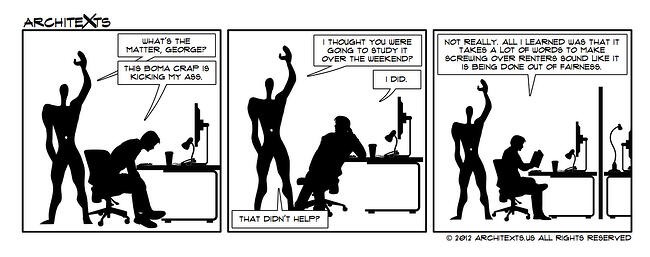Every tenant knows how much space  they're paying for. However, not every tenant knows how much space they actually occupy. As the commercial real estate market changes, measurement standards change to reflect the evolution of building design and utilization. This article will discuss how the 2010 BOMA standards has an impact on how your space is measured, the cost of your space and how you can adapt.
they're paying for. However, not every tenant knows how much space they actually occupy. As the commercial real estate market changes, measurement standards change to reflect the evolution of building design and utilization. This article will discuss how the 2010 BOMA standards has an impact on how your space is measured, the cost of your space and how you can adapt.
BOMA Standards
BOMA stands for the Building Owners and Manager's Association. It's the professional organization for office building managers. The organization defines how office space gets measured in most buildings in the United States. Under BOMA, there are many measurements for the building, all of which have different uses. Furthermore, the 2010 update of BOMA standards gives your landlord new flexibility to change how he allocates space in his building - potentially costing you more money.
Some of the space measuring rules in 2010 BOMA standards may already be familiar to you. They are as follows:
- Gross Measured Area - the total area of the building, measured from inside the exterior walls. Gross Building Area, which usually isn't used, measures from the outside face and leads to a larger area.
- Floor Rentable Area - the Gross Measured Area less any vertical penetrations such as stairs, elevators, plumbing chases and ductwork.
- Floor Common Area - the space on the floor that is not specific to any tenant and is shared. Common areas include hallways, elevator lobbies, maintenance rooms, restrooms and shared conference rooms.
- Floor Usable Area - the space on the floor that is available for tenant spaces. It's calculated by subtracting the Floor Common Area and the vertical penetrations from the Gross Measured Area.
The rule of thumb is that you occupy the usable area, but you pay rent on your pro-rata share of the rentable area. Here's an example:
-
You equally share a 20,000 gross square foot floor with two other tenants
-
The floor has 500 square feet of vertical penetrations
-
The floor has 3,000 square feet of common area
-
Result: You are responsible for paying for 6,500 square feet of space even though you only occupy 5,500 square feet.
Why? Since you occupy one-third of the floor, you pay for one-third of the 19,500 of rentable space on the floor instead of paying for one-third of the 16,500 of usable space.
BOMA 2010 and You
Under 2010 BOMA standards, your landlord gained two new metrics and rules for space measurement:
1. Your landlord can assign common area on a per-floor or per-building basis. For instance, if most of a building's ground floor is wide-open lobby space and the next 10 floors are more efficient, the landlord can make you pay for the inefficiency on the first two floors even if you're on the sixth floor.
2. Your landlord can use "regional standards" to include exterior corridors as rentable area, increasing the size of the building - and your rent.
To download eBooks on the 2010 BOMA standards, click here.
Managing the Impact of BOMA Standards
The BOMA standards open up new opportunities for your landlord, but they also expose mistakes he may make when overcharging you. For instance, if your landlord forgets to subtract vertical penetrations from your floor area, you could end up paying for more space than you actually occupy.
The solution? Have an architect do your measurement, and have a professional negotiate your leases. Measurement discrepancies, careful substitution of terms like "rentable" and "usable" and strategic use of BOMA standards can give your landlord a leg up. Understanding the BOMA standards and having an expert in your corner levels the playing field.
Arm yourself with the latest knowledge in real estate. Download our FREE guide to upcoming FASB changes:









